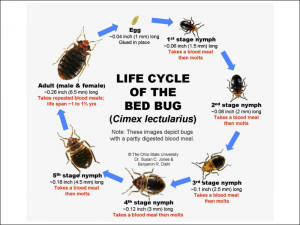Bed bugs have been big news in recent years. They seem to be thriving in human habitats and are becoming resistant to pesticides. The only nutritional need for this tick- and louse-like tiny insect is human blood. Plaguing households back to ancient Egypt, bed bugs arrived in the United States with the first colonists. Changing pest control and prevention, banning of DDT, and an increase in international travel have aided a resurgence of them beginning in the 1990s.
Here are some more bed bug facts you might not have known and might help you understand them better.
Not Just for Beds
These creatures hide in mattresses and baseboards as well as in the cushions of chairs and couches. You’ll also find them in appliances, electrical outlets, behind peeling paint and wallpaper, and inside any tiny crack. Sure, you can vacuum them up, but bed bugs are right at home in a vacuum bag and
Thought a house was only where you’ll find them? False. These tiny insects (4-5 millimeters at most) can be found in clothing and luggage. They’ve infested hotel rooms, restaurants, clothing stores, trains, movie theaters, offices, hospitals, and wherever people are and the room temperature doesn’t exceed 122°F.
Appearance
Bed bugs are about as small as an apple seed. Their bodies consist of three segments, antenna, and six legs. A flat, oval-shaped body is the trademark along with a reddish-brown color. After feeding, they take on a balloon-like, elongated appearance. Young nymphs are even smaller and so are the eggs, about as small as a pinhead and pearl-white.
Behaviors
Bed bugs are more likely to feed between midnight and 5:00am, when their human hosts are asleep. They can sense carbon dioxide and body heat and will travel several yards from a hiding spot. It takes 5-10 minutes to feed, during which the skin is probed until a blood source is found. Feeding once every three to seven days, the insect can ingest seven times its own weight.
Reproduction
Male bed bugs have a profound interest in females. Their method is different than most other species in that it involves stabbing the female in the abdominal body wall. This is called traumatic insemination. Sperm are released directly into the body cavity and travel to the ovaries, where eggs are fertilized.
Females are scarred by this process and must heal. Another means in which bed bugs spread is when females try to escape the group to avoid another stabbing. In fact, females that are injured repeatedly produce fewer eggs than those who mate just once.
In her one-year life span, a bed bug can lay hundreds of eggs. Anywhere from five to 20 eggs can be produced and laid anywhere after one meal. They hatch in six to nine days at room temperature and do so 97% of the time.
Maturity
Nymphs go through five life stages before reaching adulthood. Temperatures and food availability affect the time it takes, but from egg to adult is about 37 days. Each stage requires at least one feeding. At room temperature, according to bed bug studies, a well-fed adult will live from 99 to 300 days.
If a bed bug does not eat, it will die of dehydration within 70 days. More favorable temperature and humidity conditions can increase this time, which is one reason they congregate in such large numbers.
Getting Rid of Them
It is hard to get rid of bed bugs. One pregnant bug can start a whole new infestation. Heat treatment is one of the most effective strategies, while chemicals and pesticides may work but either trigger health issues in people or the bugs have become resistant to some compounds. Prevention is best. It involves washing clothes after traveling, checking hotel rooms for bugs, cleaning a suitcase upon return, and frequent vacuuming.
Also, reducing clutter in every room and sealing up cracks helps. You can limit places for shelter and seal up places small bugs can enter through.
Bed bugs are hardy creatures that have affected humans for thousands of years. Be vigilant, quick, and aggressive if they’re present. Do your best to prevent them from taking hold.
If you really want to get rid of bed bugs today try SayByeBugs! It was developed as a safe and highly effective alternative among a sea of products that rarely deliver on their promises.